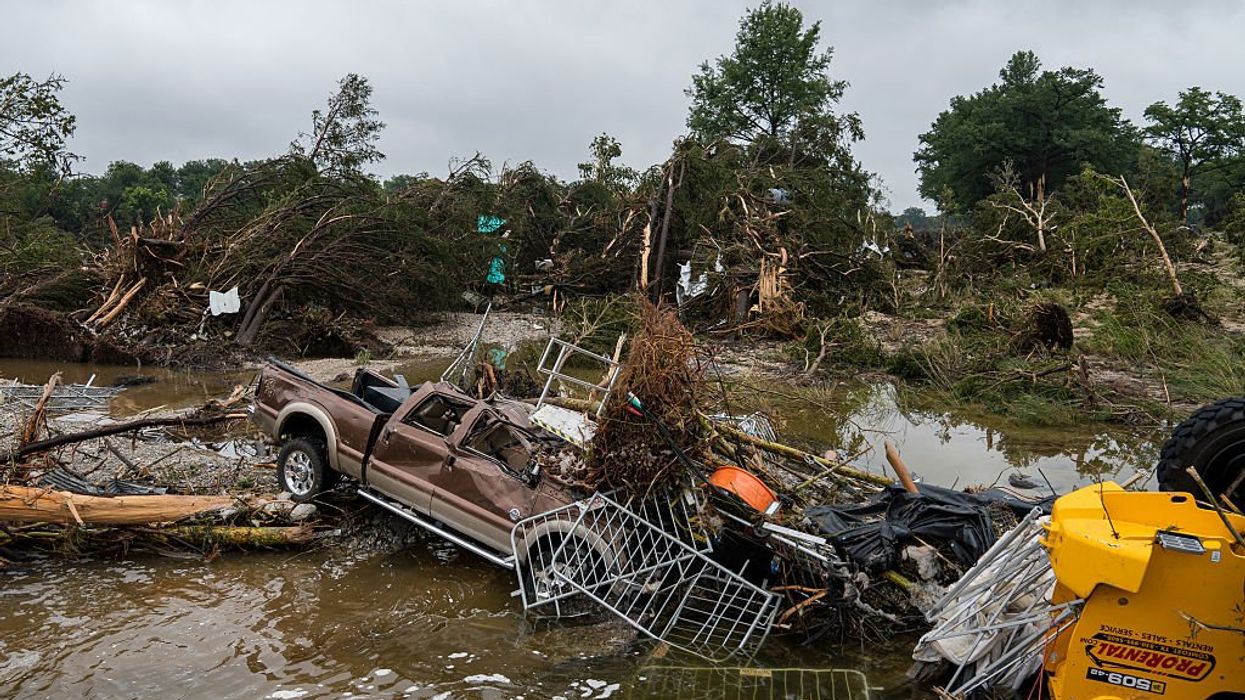As search teams in Texas work through Sunday to locate flood victims after the Guadalupe River overflowed days earlier, government officials have begun to point fingers over who is to blame for the deadly disaster.
At a press conference, Texas Division of Emergency Management Chief Nim Kidd said, "Listen, everybody got the forecast from the National Weather Service. It did not predict the amount of rain that we saw."
In the same briefing, Dalton Rice, the city manager for Kerrville, Texas, said that the catastrophic flash flooding happened because the skies “dumped more rain than what was forecasted."
The National Weather Service (NWS) issued a flash flood warning at 1:14 a.m. Friday for a portion of Kerr County, where the majority of flood-related deaths have been reported. However, it would be at least four hours before any county or city government entity posted evacuation directions on social media, reported KXAN.
The NWS was among the government agencies targeted by the Department of Government Efficiency (DOGE) in its effort to streamline the federal bureaucracy, resulting in the loss of approximately 600 staffers.
In May, all five living former directors of the NWS—a branch of the National Oceanic and Atmospheric Administration (NOAA), sent a letter expressing concerns that proposed budget cuts under the Donald Trump administration "leave the nation’s official weather forecasting entity at a significant deficit… just as we head into the busiest time for severe storm predictions like tornadoes and hurricanes.” The letter stated that under-resourced forecast offices could lead to preventable loss of life.
This policy aligns with Project 2025, a proposal initiated by the Heritage Foundation that advocates for significant reforms to the federal government, including the "dismantling" of NOAA. Additionally, Trump has proposed eliminating the Federal Emergency Management Agency (FEMA), suggesting that states should primarily manage their own preparations and responses to extreme weather. Disbanding FEMA would necessitate legislative action from Congress.
Homeland Security Secretary Kristi Noem criticized the current system used to alert the public about potential weather threats, “When President Trump took office… he said he wanted to fix [that], and is currently upgrading the technology. And the National Weather Service has indicated that with that and NOAA, that we needed to renew this ancient system that has been left in place with the federal government for many, many years, and that is the reforms that are ongoing,” Noem explained.
During the joint press conference with Texas Governor Greg Abbott, Noem confirmed that President Trump has already committed to honoring the governor's federal disaster declaration request, ensuring rapid deployment of federal resources. Approval of a federal disaster declaration speeds up the allocation of emergency resources and funding. Long-term recovery efforts will focus on rebuilding infrastructure and assessing flood preparedness measures for the region, which has a history of flooding.
In a message on Truth Social, Trump said, "Melania and I are praying for all of the families impacted by this horrible tragedy. Our Brave First Responders are on site doing what they do best. GOD BLESS THE FAMILIES, AND GOD BLESS TEXAS!"
Scientists and experts attribute climate change as a significant factor in increasing the intensity and frequency of extreme rainfall events, such as the one experienced in Texas. A warmer atmosphere can hold more moisture, leading to heavier downpours. Some studies suggest this event is "precisely" the type of rainfall scientists expect to become more common due to a warming climate.
On Friday, Trump signed the One Big Beautiful Bill Act, a $4 trillion tax and spending package proposed by congressional Republicans. This legislation effectively eliminates the key climate and clean energy provisions included in the Inflation Reduction Act, which was signed into law by then-President Joe Biden in 2022.
Over the past several hours, rescue teams have successfully saved more than 850 individuals using helicopters, boats, and drones to locate victims and assist those stranded in trees and isolated camps. Local officials report that at least 51 people, including 15 children, have lost their lives due to the flooding in Texas.Hugo Balta is the executive editor of the Fulcrum and the publisher of the Latino News Network.
SUGGESTION: Just the Facts: Trump Signs ‘Big Beautiful Bill’
 U.S. President Donald Trump, joined by first lady Melania Trump, delivers remarks during an Independence Day military family picnic on the South Lawn of the White House on July 04, 2025 in Washington, DC. At the picnic President Trump signed the One, Big Beautiful Bill Act into law. Photo by Samuel Corum/Getty Images
U.S. President Donald Trump, joined by first lady Melania Trump, delivers remarks during an Independence Day military family picnic on the South Lawn of the White House on July 04, 2025 in Washington, DC. At the picnic President Trump signed the One, Big Beautiful Bill Act into law. Photo by Samuel Corum/Getty Images




















